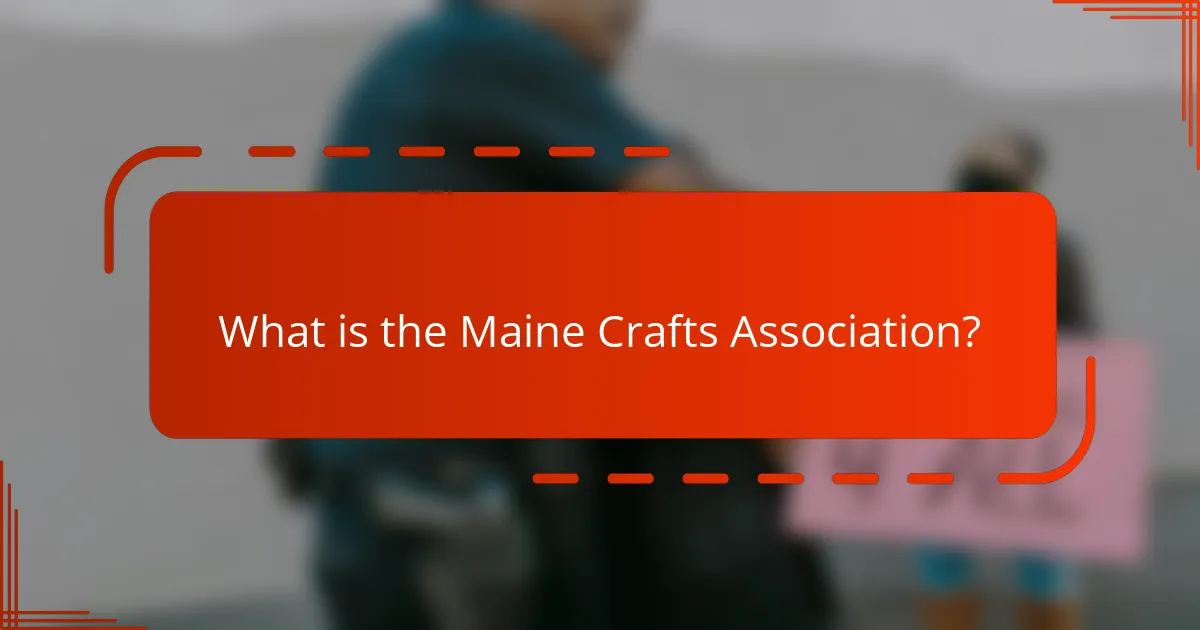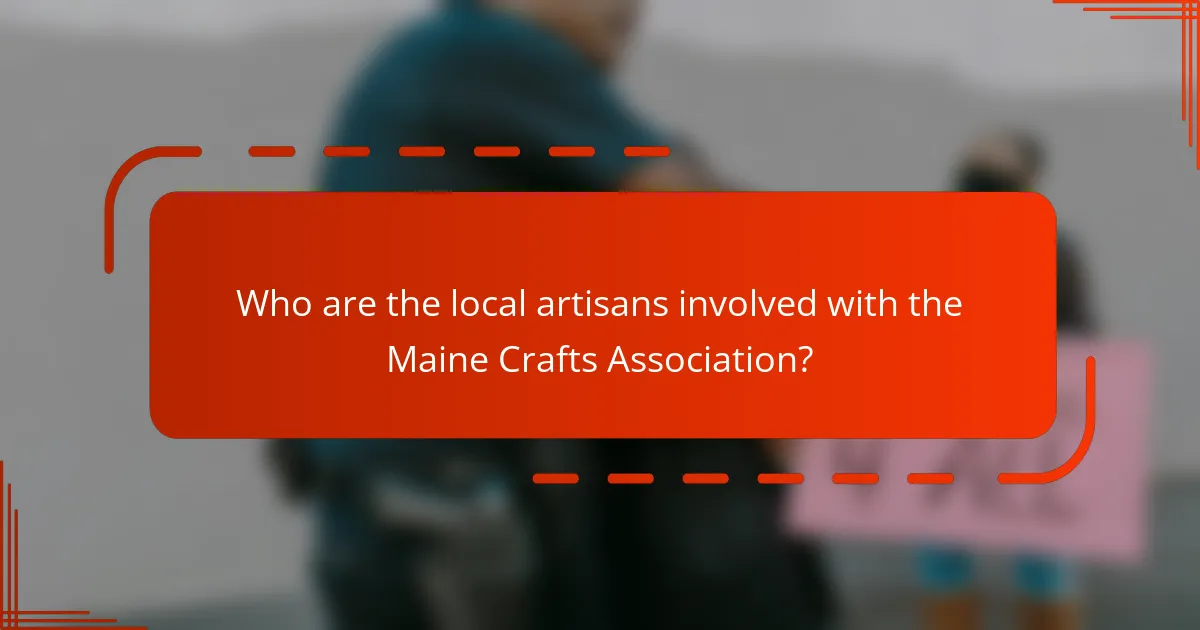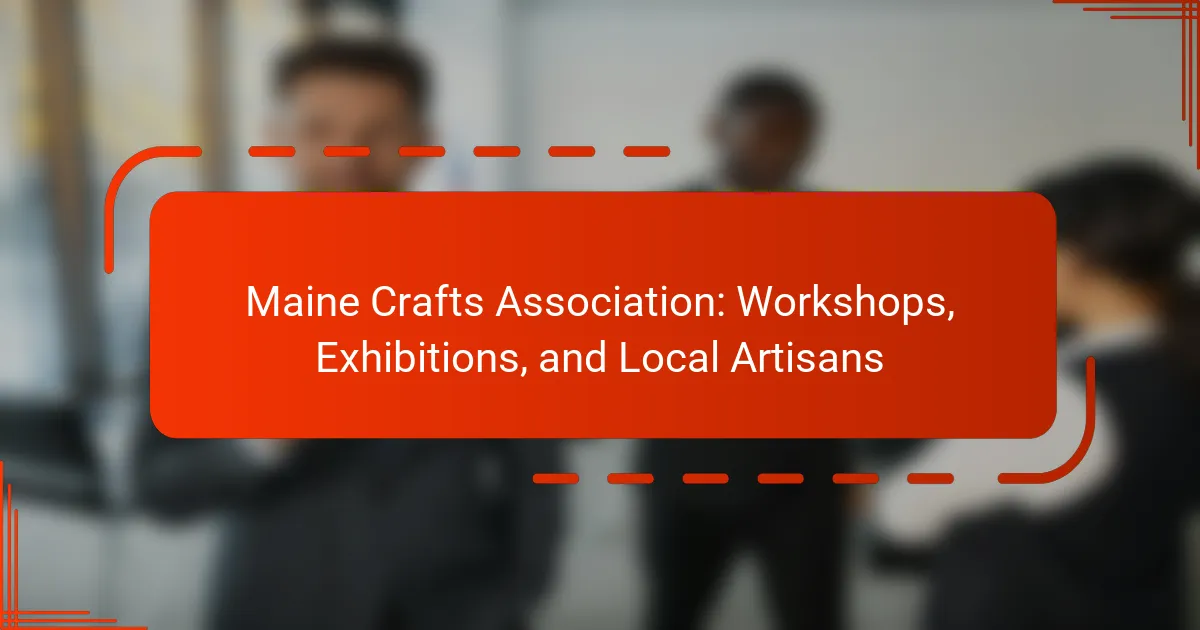The Maine Crafts Association is a nonprofit organization established in 1985 that supports and promotes craft artists in Maine. It provides resources such as workshops, exhibitions, and networking opportunities to enhance the visibility of local artisans specializing in various crafts, including pottery, woodworking, textiles, and jewelry. The association hosts multiple exhibitions each year, including the “Maine Craft Weekend,” showcasing high-quality craftsmanship and fostering community engagement. Through educational programs and collaborative efforts, the Maine Crafts Association plays a vital role in advocating for the craft sector and enriching the state’s economy.

What is the Maine Crafts Association?
The Maine Crafts Association is a nonprofit organization dedicated to supporting and promoting craft artists in Maine. It serves as a resource for artisans, offering workshops, exhibitions, and networking opportunities. The association aims to enhance the visibility of Maine’s craft community. It also provides educational programs to improve the skills of local artisans. Founded in 1985, the organization has a long history of fostering creativity and collaboration among craft makers. The Maine Crafts Association plays a crucial role in advocating for the craft sector within the state’s economy.
How does the Maine Crafts Association support local artisans?
The Maine Crafts Association supports local artisans through various initiatives. It offers workshops that enhance artisans’ skills and business knowledge. These workshops cover topics such as marketing, pricing, and product development. The association also organizes exhibitions that showcase local artisans’ work. This exposure helps artisans reach a broader audience and potentially increase sales. Additionally, the Maine Crafts Association provides networking opportunities for artisans to connect with each other. This fosters collaboration and community among local craftspeople. Overall, these efforts contribute to the growth and sustainability of Maine’s artisan economy.
What programs are offered by the Maine Crafts Association?
The Maine Crafts Association offers various programs focused on supporting local artisans. These programs include workshops, exhibitions, and professional development opportunities. Workshops provide hands-on experiences in different craft techniques. Exhibitions showcase the work of Maine artisans to the public. Professional development programs help artisans enhance their business skills. The association also organizes events that foster community engagement. These initiatives aim to promote the craft industry in Maine.
How does the association promote craftsmanship in Maine?
The Maine Crafts Association promotes craftsmanship in Maine through workshops and exhibitions. The association organizes hands-on workshops that teach various crafting techniques. These workshops are led by experienced artisans who share their skills. Additionally, the association hosts exhibitions that showcase local artisans’ work. These events provide visibility and recognition to Maine’s craft community. The association also connects artisans with resources and networking opportunities. This support fosters collaboration and innovation among craftsmen. Overall, the Maine Crafts Association plays a vital role in enhancing the craftsmanship landscape in the state.
What role do workshops play in the Maine Crafts Association?
Workshops play a crucial role in the Maine Crafts Association by providing educational opportunities for artisans. They facilitate skill development in various craft disciplines. Workshops also foster community engagement among local artisans. Participants can share techniques and network with peers. The Maine Crafts Association hosts a variety of workshops throughout the year. These workshops often feature experienced instructors from the craft community. They cover topics ranging from traditional crafts to contemporary techniques. This educational approach strengthens the local craft economy and promotes cultural heritage.
What types of workshops are available for artisans?
Artisans can participate in various types of workshops. These workshops include pottery, woodworking, textile arts, and metalworking. Each workshop focuses on specific skills and techniques relevant to the craft. For instance, pottery workshops teach wheel throwing and glazing methods. Woodworking workshops cover joinery and finishing techniques. Textile arts workshops often include sewing, weaving, and dyeing. Metalworking workshops typically focus on blacksmithing and jewelry making. These workshops are designed to enhance artisans’ skills and foster creativity.
How can participants benefit from attending these workshops?
Participants can benefit from attending these workshops by gaining hands-on experience in various crafts. They can learn new techniques and skills directly from experienced artisans. Workshops often provide access to specialized tools and materials not readily available elsewhere. Networking opportunities arise as participants connect with fellow craft enthusiasts and professionals. Participants can receive personalized feedback on their work, enhancing their artistic development. Additionally, workshops foster creativity and inspire new ideas through collaborative environments. Overall, these workshops contribute to personal growth and community engagement in the arts.

What exhibitions are hosted by the Maine Crafts Association?
The Maine Crafts Association hosts several exhibitions throughout the year. These exhibitions showcase the work of local artisans and craft makers. They often include a variety of mediums such as ceramics, textiles, and woodworking. Events like the “Maine Craft Weekend” highlight the state’s rich craft heritage. Additionally, the association organizes juried exhibitions to feature high-quality craftsmanship. These events provide a platform for artists to gain visibility and connect with the community. The exhibitions also promote the appreciation of handmade crafts in Maine.
How do exhibitions showcase local artisans’ work?
Exhibitions showcase local artisans’ work by providing a platform for their crafts to be displayed. These events often feature a variety of handmade items, including pottery, textiles, and jewelry. Artisans can interact directly with the public, fostering community engagement. Exhibitions also promote local culture and heritage through the representation of traditional techniques. In Maine, events organized by the Maine Crafts Association highlight the skills of local artisans. This exposure can lead to increased sales and opportunities for collaboration. Additionally, exhibitions often include demonstrations, allowing artisans to showcase their processes. Such events are crucial for building networks among artists and potential customers.
What are the key features of these exhibitions?
Key features of these exhibitions include showcasing local artisans’ work. They highlight a variety of crafts, including woodworking, pottery, and textiles. These exhibitions often provide interactive experiences for visitors. They may include live demonstrations by artisans. Educational workshops are frequently part of the exhibitions. The exhibitions aim to promote community engagement and support local artists. They also serve as a platform for networking among artisans. Many exhibitions feature themed displays that change regularly.
How can artisans participate in the exhibitions?
Artisans can participate in exhibitions by applying through the Maine Crafts Association. They need to submit an application that includes their portfolio and details about their work. The association reviews applications based on criteria like craftsmanship and originality. Selected artisans are then invited to showcase their work at upcoming exhibitions. Participation also involves adhering to guidelines set by the association. This process ensures a diverse representation of local artisans.
What impact do exhibitions have on the local craft community?
Exhibitions significantly enhance the local craft community by providing visibility and networking opportunities. They allow artisans to showcase their work to a wider audience. This exposure can lead to increased sales and commissions. Additionally, exhibitions foster collaborations among local artists. They create a platform for sharing techniques and ideas. Local craft communities often see a boost in tourism during these events. This influx can benefit local businesses and the economy. Overall, exhibitions serve as a catalyst for growth and innovation within the craft sector.
How do exhibitions promote networking among artisans?
Exhibitions promote networking among artisans by providing a platform for interaction. They facilitate face-to-face meetings between artisans and potential collaborators. Exhibitions often feature workshops, encouraging skill sharing and knowledge exchange. These events attract a diverse audience, including buyers and industry professionals. This diversity allows artisans to showcase their work to a broader network. Exhibitions also foster community building among artisans through shared experiences. Networking opportunities can lead to partnerships and collaborations. According to the Maine Crafts Association, such events enhance visibility and promote the local craft community.
What opportunities do exhibitions create for artisans and visitors?
Exhibitions create networking opportunities for artisans and visitors. Artisans can connect with potential customers and collaborators. Visitors gain access to unique handmade products and local craftsmanship. Exhibitions often include workshops, allowing skill development for attendees. They serve as a platform for artisans to showcase their work publicly. This exposure can lead to increased sales and brand recognition. Artisans can receive direct feedback from visitors, enhancing their craft. Overall, exhibitions foster community engagement and cultural exchange.

Who are the local artisans involved with the Maine Crafts Association?
The Maine Crafts Association involves a diverse group of local artisans. These artisans specialize in various crafts including pottery, woodworking, textiles, and jewelry. Many of them participate in workshops and exhibitions organized by the association. They showcase their unique creations and promote craftsmanship in Maine. The association supports these artisans through networking and educational opportunities. Each artisan contributes to the vibrant craft community in the region. Specific names of artisans may vary, reflecting the dynamic nature of local crafts. The Maine Crafts Association fosters collaboration among these talented individuals.
What types of crafts do local artisans create?
Local artisans create a variety of crafts, including pottery, textiles, and woodworking. Pottery often features unique glazes and designs. Textiles may include handwoven fabrics and intricate quilts. Woodworking encompasses furniture, sculptures, and decorative items. Additionally, artisans may produce jewelry and metalwork. These crafts reflect local culture and traditions. Many artisans participate in community exhibitions to showcase their work. The Maine Crafts Association supports these artisans through workshops and events.
How do artisans maintain their unique styles and traditions?
Artisans maintain their unique styles and traditions through a combination of techniques and practices. They often rely on ancestral knowledge passed down through generations. This knowledge includes specific methods, materials, and cultural significance of their crafts. Artisans participate in workshops and community events to share and refine their skills. They also engage in exhibitions to showcase their work and connect with audiences. By collaborating with other artisans, they can exchange ideas and techniques. Additionally, maintaining a connection to local culture and history helps preserve their unique identities. This commitment to tradition is evident in the craftsmanship and storytelling behind each piece.
What are the stories behind some notable artisans in Maine?
Maine is home to many notable artisans, each with unique stories. For example, Andrew Wyeth was a renowned painter known for his realistic landscapes and depictions of rural life. His work often reflected the Maine scenery and his connection to the land.
Another notable artisan is Linda K. Smith, a fiber artist who creates intricate tapestries. She draws inspiration from the natural beauty of Maine, often incorporating local themes into her work.
Ceramicist John E. H. McGowan has gained recognition for his functional pottery. His pieces often feature glazes that mimic the colors of the Maine coast, showcasing the region’s aesthetic.
These artisans contribute to Maine’s rich craft heritage. Their stories reflect a deep connection to the state’s culture, environment, and artistic traditions.
How can the community support local artisans?
The community can support local artisans by purchasing their products directly. Buying handmade goods boosts artisans’ income and promotes local craftsmanship. Engaging in local markets and fairs helps artisans gain visibility. Attending workshops fosters skill-sharing and community engagement. Promoting artisans on social media expands their reach. Collaborating with local businesses can create unique offerings. Providing feedback encourages artisans to refine their craft. Supporting local artisans strengthens the community’s cultural identity.
What are the best practices for purchasing local crafts?
Research local artisans and their crafts before purchasing. Understand the materials and techniques used. Visit local craft fairs and markets to see items firsthand. Ask artisans about their creative process and inspiration. Consider the sustainability of the materials used in the crafts. Support artisans by purchasing directly from them whenever possible. Check for authenticity labels or certifications that indicate local craftsmanship. Engage with the community to learn about the artisans’ backgrounds and stories.
How can individuals get involved with the Maine Crafts Association?
Individuals can get involved with the Maine Crafts Association by becoming a member. Membership provides access to resources, events, and networking opportunities. Members can participate in workshops and exhibitions organized by the association. The Maine Crafts Association also offers volunteer opportunities for those interested in supporting local artisans. Additionally, individuals can attend events to connect with other craftspeople and learn about the craft community.
The Maine Crafts Association is a nonprofit organization focused on supporting and promoting craft artists in Maine through various initiatives, including workshops, exhibitions, and networking opportunities. Founded in 1985, the association enhances the visibility of local artisans and provides educational programs to improve their skills. Key offerings include hands-on workshops in diverse crafts, exhibitions that showcase artisan work, and community engagement events that foster collaboration among craftspeople. The article details the association’s role in advocating for the craft sector, the types of crafts created by local artisans, and how the community can support these artists.
